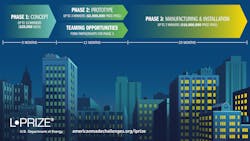DOE reprises L-Prize seeking to accelerate SSL evolution in commercial buildings
The US Department of Energy (DOE) has announced the launch of a new L-Prize initiative seeking to spur innovation in solid-state lighting (SSL) systems for commercial buildings. The program will comprise three phases where entrants first submit concepts, then selected entrants develop prototypes, and ultimately one or two winners will move to production and share a $10M (million) prize with the total prize pool being $12.2 million. The LED-centric competition encourages entrants to improve and evolve SSL systems in areas of efficacy, quality of light, connectivity, lifecycle, and innovation/inclusion.
Long-term participants in the LED and SSL sectors will of course remember the original L-Prize, but frankly it took place so long ago that many newcomers may have missed what was a landmark market transformation program. The Bright Tomorrow Lighting Prize (L-Prize) was conceived and launched in 2008 to accelerate development of LED-based replacement lamps that met extraordinarily-stringent performance and life goals in the early SSL era when products often fell short of specification and failed prematurely. Philips Electronics (really a combination of what is now separate Signify and Lumileds organizations) was the first company to officially enter the competition for a 60W-replacement lamp in 2009. The competition included that A-lamp category and originally included a PAR38 competition as well.
There were subsequent entrants into the A-lamp competition including from GE Lighting and Lighting Science Group. But Philips had a significant lead in the development. Philips was declared the A-lamp winner in August 2011 and ultimately collected a $10M prize. At the time the lamp sold for around $50, but it delivered handsomely on the design goals. In 2015, the DOE said after 40,000 hours of testing of 31 lamps, lumen maintenance remained over 95%.
We published an interview with Jim Brodrick, longtime director of the DOE SSL program but now retired, in the month after the prize was awarded. The lamp had already undergone 18 months of testing and Broderick said the lessons learned in the L-Prize program would be applied throughout the SSL industry. Alas, the PAR38 competition was suspended in 2014 because the efficacy levels set by the DOE simply were not achievable.
The new version of the L-Prize targeted at commercial buildings is far less defined. There is no preconceived notion of a product form factor or required performance levels. We’d presume since the target is commercial buildings that the entrants will be working on integral luminaires. And most likely the function that entrants will seek to replace is the troffer widely deployed in office spaces.
The DOE will host a webinar on June 10 to answer questions about the program. The concept phase is open now. As many as ten entrants will be eligible to win $20,000 each. The DOE will also be hosting a comment period along with the concept phase with stakeholders having the chance to help shape the prototype and manufacturing stages.
The prototype phase will have a $2M prize pool that can be split among as a many as three entrants. Moreover, the DOE’s Pacific Northwest National Laboratory (PNNL) will issue an RFI at the start of the prototype phase that will facilitate teaming entrants in partnerships for the manufacturing and installation phase.
An expert review panel will judge the ultimate success of the entrants in the manufacturing and installation phase. As with the original L-Prize, the entrants will have to legally reside or be based in the US. And the entrants will be required to manufacture the winning products in a US facility.
The DOE has posted a PDF with rules that bound the program. Points will be awarded across logistic and actual performance categories. For example, lifecycle cost and sustainability will come into play. And performance categories such as connectivity have a long list of what the documents calls topics with each being able to earn points — for instance, reporting of energy usage. The program will be administered by the National Renewable Energy Laboratory with technical assistance from PNNL.
LEDs Magazine chief editor MAURY WRIGHT is an electronics engineer turned technology journalist, who has focused specifically on the LED & Lighting industry for the past decade.
For up-to-the-minute LED and SSL updates, why not follow us on Twitter? You’ll find curated content and commentary, as well as information on industry events, webcasts, and surveys on our LinkedIn Company Page and our Facebook page.

Maury Wright | Editor in Chief
Maury Wright is an electronics engineer turned technology journalist, who has focused specifically on the LED & Lighting industry for the past decade. Wright first wrote for LEDs Magazine as a contractor in 2010, and took over as Editor-in-Chief in 2012. He has broad experience in technology areas ranging from microprocessors to digital media to wireless networks that he gained over 30 years in the trade press. Wright has experience running global editorial operations, such as during his tenure as worldwide editorial director of EDN Magazine, and has been instrumental in launching publication websites going back to the earliest days of the Internet. Wright has won numerous industry awards, including multiple ASBPE national awards for B2B journalism excellence, and has received finalist recognition for LEDs Magazine in the FOLIO Eddie Awards. He received a BS in electrical engineering from Auburn University.





![The DesignLights Consortium continues to make progress in shifting outdoor lighting products and implementation practices toward a more restrained and thoughtful strategy. [Image does not represent a DLC qualified fixture.] The DesignLights Consortium continues to make progress in shifting outdoor lighting products and implementation practices toward a more restrained and thoughtful strategy. [Image does not represent a DLC qualified fixture.]](https://img.ledsmagazine.com/files/base/ebm/leds/image/2024/08/66be810888ae93f656446f61-dreamstime_m_265700653.png?auto=format,compress&fit=&q=45&h=139&height=139&w=250&width=250)